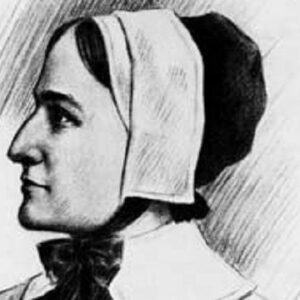Anne Hutchinson (born Anne Marbury) was a prominent participant in the Massachusetts Bay Colony’s Antinomian Controversy. She was a devotee of John Cotton’s spirit-centered theology. She believed that salvation was a gift from God and that it could not be earned through human effort or penitence. She freely discussed these subjects during weekly discussions and meetings held at her home, and her following quickly grew. She emphasized the efficacy of faith as a means of redemption. Hutchinson chastised the New England Puritan ministers for their stifling moral concepts. Her principles were diametrically opposed to those of the Boston’s recognized Puritan clergy. Boston’s civil authorities felt threatened as well by her theological beliefs. As a result, she was tried by the General Court for alleged ministerial defamation. She was officially excommunicated following her trial before the Boston Church. Following this, she and other dissenters founded a settlement on Aquidneck Island. She later lived in the Long Island Sound. In 1643, she was assassinated along with her other family members and servants.
Childhood & Adolescence
Anne Hutchinson was born in the family of Francis Marbury and Bridget Dryden in Alfred, Linconshire, England. On 20 July 1591, she was baptized.
She was the third child of her parents’ second marriage and the third of their fifteen children. For the first 15 years of Anne Hutchison’s life, her family lived in her birthplace. She was educated at home by her father.
She married William Hutchinson, a fabric merchant, on 9 August 1612, when she was 21 years old. The ceremony took place at London’s St Mary Woolnoth Church.
Later Years of Anne
Anne Hutchinson was profoundly influenced by John Cotton’s preachings in Boston, a minister whose doctrine emphasized ‘absolute grace.’
John Wheelwright, her husband’s brother-in-law, preached similarly. Hutchinson began holding biweekly meetings at her home, where she discussed her own radical interpretations of the Bible, inspired by their beliefs.
When John Cotton was forced to flee to New England in 1633, Hutchinson and her family arrived a year later. They began staying at the Shawmut peninsula in Boston, where Anne took on the role of a midwife. While assisting women during childbirth, she also offered spiritual guidance to them.
Soon after, she began hosting conventicles meetings at her home, and each week, over 60 people, both male and female, gathered in her home to discuss Cotton’s sermons.
In these meetings, Hutchinson advanced her own position that salvation is only possible through’spiritual intuition.’ Governor Vane was also a frequent attendee at these meetings.
Her unorthodox sermons and preaching enraged the Puritan church, which accused her and her followers of Antinomianism, which is defined as practicing something contrary to the law of grace.
When Governor John Winthrop succeeded Henry Vane in 1637, the orthodox party resolved to deal with the rivals. Hutchison was tried on 7 November 1637 on charges of maligning Puritan ministers and endorsing disturbing opinions. The trial was presided over by Winthrop.
Hutchinson was expelled from the country and condemned as a ‘woman unfit for our society’ by the court. Hutchison was placed under house arrest following the conclusion of the trial.
She stayed at the Roxbury home of Joseph Weld. Hutchinson faced a church trial in his home church in Boston on 15 March 1638. Reverend John Davenport served as the trial’s chief prosecutor.
On 22nd March, following a gruesome week-long investigation, she read out her recantation to parishioners, in which she admitted to being wrong in her beliefs and behavior toward the Puritan orthodox religion.
Despite her recantation, Anne Hutchison and her supporters were expelled from the colony and excommunicated from the church.
She established a settlement on Aquidneck Island with her family and followers (now known as Rhode island).
However, due to the threat posed by the Massachusetts Bay colony, Hutchison and the settlers were forced to relocate to Connecticut and then to Split Rock, New Netherland in 1642.
However, the settlers quickly became victims of the local upheaval. During the Kieft’s war, the indigenous people of the area attacked the colony of New Netherland. Although the precise date of the massacre is unknown, it must have occurred in August 1643.
Wampage, the Siwanoy chief, assassinated Hutchinson, her children, and servants. Among her daughters, only one survived. This incident was viewed as divine judgment by some residents of Massachusetts.
Personal History and Legacies
In 1612, she married William Hutchinson, a fabric merchant. The ceremony took place at London’s St Mary Woolnoth Church.
Anne gave birth to fifteen children. Eleven of them survived to sail to New England, but only Susanna, the youngest daughter, survived the Indian attack.
Estimated Net Worth
The estimated net worth of Anne is unavailable.
Trivia
Anne Hutchison was the model for the fictional character Hester Prynne in Nathaniel Hawthorne’s renowned novel ‘The Scarlet Letter’.
She was portrayed in William Gibson’s play ‘Goodly Creatures,’ and the Intermezzo Opera Company performed Dan Shore’s opera ‘Anne Hutchinson’ twice in Boston, Massachusetts in 2014.
Among the numerous descendants of Hutchison, the most notable are US Presidents Franklin Roosevelt and George H. W. Bush, as well as US politicians such as Mitt Romney, Stephen A. Douglas, and Melville Weston Fuller, chief justice of the US Supreme Court.
One statue of Hutchison stands in front of the State House in Boston, while another is located in Quincy, Massachusetts on the corner of Beale Street and Grandview Avenue.


